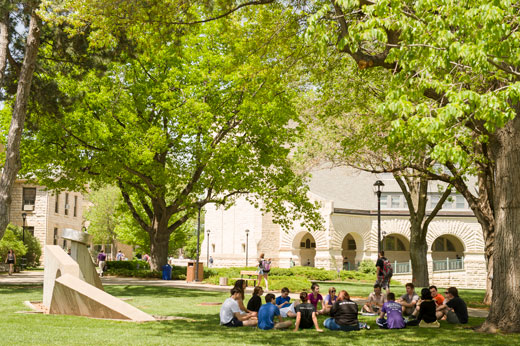University increases enrollment at three campuses and retention, graduation rates
Wednesday, Oct. 2, 2019

In the second year of a strategic enrollment initiative, Kansas State University set records for retention and graduation rates. | Download this photo.
MANHATTAN — Kansas State University continues to promote the value of higher education and has increased enrollment in online programs and at the Polytechnic and Olathe campuses while total enrollment dips.
The university's Global, Polytechnic and Olathe campuses all had an increased number of students enrolled, which offsets an enrollment decline on the Manhattan campus. Total university enrollment is down 502 students, reflecting a national trend in higher education.
"As the ebb and flow of higher education continues across the nation, K-State's diverse campuses accommodate a variety of interests — from technical and aviation programs to advanced degrees for working professionals — that meet students' changing interests," said Chuck Taber, provost and executive vice president. "It is K-State's student-first mentality that is improving retention and graduation rates across the university."
The retention of freshmen to sophomores is again highest in university history at 85.8%, and the university graduated a near-record 3,219 students in May. The university's four-year graduation rate is 41.6% and the six-year graduation rate is 64.8% — both records for the university.
Preliminary numbers from the Kansas Board of Regents' report show overall headcount decreased by 2.3%. The board has started reporting full-time equivalency, or FTE, in addition to headcount to provide more uniform data. The Regents calculate full-time equivalency by dividing the total number of undergraduate credit hours taken in a semester by 15 and graduate credit hours by 12. Using this metric, FTE is down about 3%.
K-State is beginning the second year of a strategic enrollment management effort designed to increase its overall enrollment to boost net tuition revenue. Improving the educational experience and making scholarships more accessible remain top priorities for the university as a land-grant institution.
"We've completely revamped our scholarship programs and are finding new ways to increase the value of our already excellent degrees," Taber said. "Higher education has been proven to be one of the best investments a person can make — with demonstrably proven increased lifetime earnings and quality of life. The prosperity of our state and country depends on a well-educated populace."
According to Taber, K-State is on track with its strategic enrollment plan and the university is taking a long-term view of the turnaround.
"We are committed to growing in a financially prudent way that allows us to be sustainable even as higher education continues to evolve rapidly," Taber said.
"The improvements in retention and graduation rates are a testament to the focus of K-State 2025 and the hard work and person-to-person efforts of our excellent faculty, staff, administration and students," said Brian Niehoff, associate provost for institutional effectiveness.
The university's new enrollment priorities and renowned family atmosphere have garnered national attention. Money magazine has repeatedly rated Kansas State University as the top value in Kansas and the student experience is continually rated one of the best in the nation, according to The Princeton Review.
In addition, Insight Into Diversity magazine and Campus Pride have named the university among the best in the nation for supporting inclusion and diversity, another top priority for the university. Multicultural students now account for 16.3% of the student body — the highest in university history — and Hispanic student enrollment continues at an all-time high.
